Proportionated Distributions in Spatiotemporal Structure of the World Cultural Heritage Sites: Analysis and Countermeasures
Abstract
1. Introduction
2. Materials and Methods
2.1. Materials
2.2. Methodology
2.2.1. Big Data Cleaning
2.2.2. Statistical Analysis of Cultural Heritage
2.2.3. Risk Assessment of Cultural Heritage
3. Results and Analysis
3.1. Spatial-Temporal Characteristics of Cultural Heritage Sites
3.1.1. Listed Time of WCHS Sites
3.1.2. Chronological Features of WCHS Sites
3.1.3. Spatial Characteristics of Cultural Heritage Sites
3.2. Spatial Distribution of Material Types in Cultural Heritage Sites
3.3. Civilization Inheritance Characteristics of Cultural Heritage Sites
3.4. Criteria Used in Declarations
3.5. World Cultural Heritage (WCHS) in Danger and Cultural and Natural Mixed World Heritage
3.5.1. Mixed Heritage
3.5.2. Endangered Heritage Sites
3.6. Spatial Distribution of Capital Investment
3.7. Risk Assessment of the Cultural Heritage Sites
3.7.1. Risk Assessment of Cultural Heritage Sites under the Influence of Natural Factors
Volcano Hazard Risk Assessment
Landslide Hazard Risk Assessment
Seismic Disasters Hazard Risk Assessment
3.7.2. Risk Assessment of Cultural Heritage under the Influence of Human Factors
4. Conclusions and Perspectives
4.1. Conclusions
4.2. Perspectives
Author Contributions
Funding
Data Availability Statement
Acknowledgments
Conflicts of Interest
References
- Meskell, L. UNESCO’s World Heritage Convention at 40 Challenging the Economic and Political Order of International Heritage Conservation. Curr. Anthropol. 2013, 54, 12. [Google Scholar] [CrossRef]
- Wang, X.; Ren, H.; Wang, P.; Yang, R.; Luo, L.; Cheng, F. A Preliminary Study on Target 11.4 for UN Sustainable Development Goals. Int. J. Geoheritage Parks 2018, 6, 6. [Google Scholar] [CrossRef]
- Target 11.4: Strengthen Efforts to Protect and Safeguard the World’s Cultural and Natural Heritage: Indicator 11.4.1. Available online: https://unstats.un.org/sdgs/metadata/ (accessed on 15 December 2020).
- Wang, J.-J. Flood risk maps to cultural heritage: Measures and process. J. Cult. Herit. 2015, 16, 210–220. [Google Scholar] [CrossRef]
- Seyedashrafi, B.; Kloos, M.; Neugebauer, C. Heritage Impact Assessment, beyond an Assessment Tool: A comparative analysis of urban development impact on visual integrity in four UNESCO World Heritage Properties. J. Cult. Herit. 2020. [Google Scholar] [CrossRef]
- Caust, J.; Vecco, M. Is UNESCO World Heritage recognition a blessing or burden? Evidence from developing Asian countries. J. Cult. Herit. 2017, 27, 1–9. [Google Scholar] [CrossRef]
- Marzeion, B.; Levermann, A. Loss of cultural world heritage and currently inhabited places to sea-level rise. Environ. Res. Lett. 2014, 9. [Google Scholar] [CrossRef]
- Landorf, C. Managing for sustainable tourism: A review of six cultural World Heritage Sites. J. Sustain. Tour. 2009, 17, 53–70. [Google Scholar] [CrossRef]
- Spezzano, P. Mapping the susceptibility of UNESCO World Cultural Heritage sites in Europe to ambient (outdoor) air pollution. Sci. Total Environ. 2021, 754, 142345. [Google Scholar] [CrossRef] [PubMed]
- Pan, Y.; Wang, X.; Guo, R.; Yuan, S. Seismic damage assessment of Nepalese cultural heritage building and seismic retrofit strategies: 25 April 2015 Gorkha (Nepal) earthquake. Eng. Fail. Anal. 2018, 87, 80–95. [Google Scholar] [CrossRef]
- Zhuang, X.; Yao, Y.; Li, J. Sociocultural Impacts of Tourism on Residents of World Cultural Heritage Sites in China. Sustainability 2019, 11, 840. [Google Scholar] [CrossRef]
- Toivonen, T.; Heikinheimo, V.; Fink, C.; Hausmann, A.; Hiippala, T.; Järv, O.; Tenkanen, H.; Di Minin, E. Social media data for conservation science: A methodological overview. Biol. Conserv. 2019, 233, 298–315. [Google Scholar] [CrossRef]
- Chan, K.M.A.; Guerry, A.D.; Balvanera, P.; Klain, S.; Satterfield, T.; Basurto, X.; Bostrom, A.; Chuenpagdee, R.; Gould, R.; Halpern, B.S.; et al. Where are Cultural and Social in Ecosystem Services? A Framework for Constructive Engagement. BioScience 2012, 62, 744–756. [Google Scholar] [CrossRef]
- Vlami, V.; Kokkoris, I.P.; Zogaris, S.; Cartalis, C.; Kehayias, G.; Dimopoulos, P. Cultural landscapes and attributes of "culturalness" in protected areas: An exploratory assessment in Greece. Sci. Total Environ. 2017, 595, 229–243. [Google Scholar] [CrossRef]
- Holocene Volcano List. Available online: http://volcano.si.edu/list_volcano_holocene.cfm (accessed on 12 September 2020).
- Modeling and Reporting Landslides. Available online: https://pmm.nasa.gov/applications/global-landslide-model (accessed on 12 September 2020).
- GAR 2017 Atlas Risk Data and Software Download Facility. Available online: https://risk.preventionweb.net/ (accessed on 12 September 2020).
- Pesaresi, M.; Huadong, G.; Blaes, X.; Ehrlich, D.; Ferri, S.; Gueguen, L.; Halkia, M.; Kauffmann, M.; Kemper, T.; Lu, L.; et al. A global human settlement layer from optical HR/VHR rs data: Concept and first results. IEEE J. Sel. Top. Appl. Earth Obs. Remote Sens. 2013, 6, 2102–2131. [Google Scholar] [CrossRef]
- Stevens, F.R.; Gaughan, A.E.; Linard, C.; Tatem, A.J. Disaggregating census data for population mapping using random forests with remotely-sensed and ancillary data. PLoS ONE 2015, 10, e0107042. [Google Scholar] [CrossRef] [PubMed]
- Li, Q.; Lu, L.; Weng, Q.; Xie, Y.; Guo, H. Monitoring urban dynamics in the southeast U.S.A. using time-series DMSP/OLS nightlight imagery. Remote Sens. 2016, 8, 578. [Google Scholar] [CrossRef]
- IMF Data. Available online: https://www.imf.org/en/Data (accessed on 12 December 2020).
- Wirilander, H. Preventive Conservation: A Key Method to Ensure Cultural Heritage’s Authenticity and Integrity in Preservation Process. e-Conserv. Mag. 2012, 5, 164–176. [Google Scholar]
- Agapiou, A.; Lysandrou, V.; Alexakis, D.D.; Themistocleous, K.; Cuca, B.; Argyriou, A.; Sarris, A.; Hadjimitsis, D.G. Cultural heritage management and monitoring using remote sensing data and GIS: The case study of Paphos area, Cyprus. Comput. Environ. Urban Syst. 2015, 54, 230–239. [Google Scholar] [CrossRef]
- Chen, F.; You, J.; Tang, P.; Zhou, W.; Masini, N.; Lasaponara, R. Unique performance of spaceborne SAR remote sensing in cultural heritage applications: Overviews and perspectives. Archaeol. Prospect. 2018, 25, 71–79. [Google Scholar] [CrossRef]
- Chen, F.; Guo, H.; Ma, P.; Lin, H.; Wang, C.; Ishwaran, N.; Hang, P. Radar interferometry offers new insights into threats to the Angkor site. Sci. Adv. 2017, 3, e1601284. [Google Scholar] [CrossRef]
- Moise, C.; Dana Negula, I.; Mihalache, C.E.; Lazar, A.M.; Dedulescu, A.L.; Rustoiu, G.T.; Inel, I.C.; Badea, A. Remote Sensing for Cultural Heritage Assessment and Monitoring: The Case Study of Alba Iulia. Sustainability 2021, 13. [Google Scholar] [CrossRef]
- Stokes, E.C.; Seto, K.C. Characterizing urban infrastructural transitions for the Sustainable Development Goals using multi-temporal land, population, and nighttime light data. Remote Sens. Environ. 2019, 234, 111430. [Google Scholar] [CrossRef]
- Lu, L.; Weng, Q.; Guo, H.; Feng, S.; Li, Q. Assessment of urban environmental change using multi-source remote sensing time series (2000–2016): A comparative analysis in selected megacities in Eurasia. Sci. Total Environ. 2019, 684, 567–577. [Google Scholar] [CrossRef]
- Wong, L.E. Relocating East and West: UNESCO’s Major Project on the Mutual Appreciation of Eastern and Western Cultural Values. J. World Hist. 2008, 18, 26. [Google Scholar]
- King, L.M.; Halpenny, E.A. Communicating the World Heritage brand: Visitor awareness of UNESCO’s World Heritage symbol and the implications for sites, stakeholders and sustainable management. J. Sustain. Tour. 2014, 22, 768–786. [Google Scholar] [CrossRef]
- Matsuura, K. Appendix I UNESCO Universal Declaration on Cultural Diversity UNESCO Universal Declaration on Cultural Diversity. Diogenes 2005, 52, 141–145. [Google Scholar] [CrossRef]
- Miller, M.C.; Mumford, L.; Fisher, T. The Culture of Cities; Open Road Media: New York, NY, USA, 2016. [Google Scholar]
- Noam Levin, S.A.; Crandall, D.; Kark, S. World Heritage in danger: Big data and remote sensing can help protect sites in conflict zones. Glob. Environ. Chang. 2019, 55, 8. [Google Scholar]
- Brattli, T. Managing the Archaeological World Cultural Heritage: Consensus or Rhetoric? Nor. Archaeol. Rev. 2009, 42, 24–39. [Google Scholar] [CrossRef]
- Su, M.M.; Wall, G. Chinese Research on World Heritage Tourism. Asia Pac. J. Tour. Res. 2011, 16, 75–88. [Google Scholar] [CrossRef]
- Timothy, D.J.; Nyaupane, G.P. Cultural Heritage and Tourism in the Developing World: A Regional Perspective; Taylor & Francis: Abingdon-on-Thames, UK, 2009. [Google Scholar]
- Vecco, M.; Srakar, A. The unbearable sustainability of cultural heritage: An attempt to create an index of cultural heritage sustainability in conflict and war regions. Journal of Cultural Heritage 2018, 33, 293–302. [Google Scholar] [CrossRef]
- Tweed, C.; Sutherland, M. Built cultural heritage and sustainable urban development. Landsc. Urban Plan. 2007, 83, 62–69. [Google Scholar] [CrossRef]
- UNESCO. Operational Guidelines for the Implementation of the World Heritage Convention; World Heritage Centre: Paris, France, 2019; pp. 3–4. [Google Scholar]
- Hadjimitsis, D.; Agapiou, A.; Alexakis, D.; Sarris, A. Exploring natural and anthropogenic risk for cultural heritage in Cyprus using remote sensing and GIS. Int. J. Digit. Earth 2013, 6, 115–142. [Google Scholar] [CrossRef]
- Wasowski, J.; Dijkstra, T. Recent Research on Engineering Geology and Geological Engineering. In Proceedings of the 2nd GeoMEast International Congress and Exhibition on Sustainable Civil Infrastructures, Egypt 2018—The Official International Congress of the Soil-Structure Interaction Group in Egypt (SSIGE), Cairo, Egypt, 24–28 November 2018; p. 126. [Google Scholar]
- Sari, K.P. A Spatial Study on Risk Analysis of Disasters Caused by Natural Hazards to Cultural Heritage in Indonesia. J. Disaster Mitig. Hist. Cities 2018, 12, 8. [Google Scholar]
- Grimm, N.B.; Faeth, S.H.; Golubiewski, N.E.; Redman, C.L.; Wu, J.; Bai, X.; Briggs, J.M. Global change and the ecology of cities. Science 2008, 319, 756–760. [Google Scholar] [CrossRef] [PubMed]
- Agapiou, A.; Alexakis, D.D.; Lysandrou, V.; Sarris, A.; Cuca, B.; Themistocleous, K.; Hadjimitsis, D.G. Impact of urban sprawl to cultural heritage monuments: The case study of Paphos area in Cyprus. J. Cult. Herit. 2015, 16, 671–680. [Google Scholar] [CrossRef]
- Mei, Q. Protective Reuse Design for Gulangyu Cultural Heritage. In The Values of Gulangyu World Cultural Heritage; Springer: Singapore, 2020. [Google Scholar] [CrossRef]
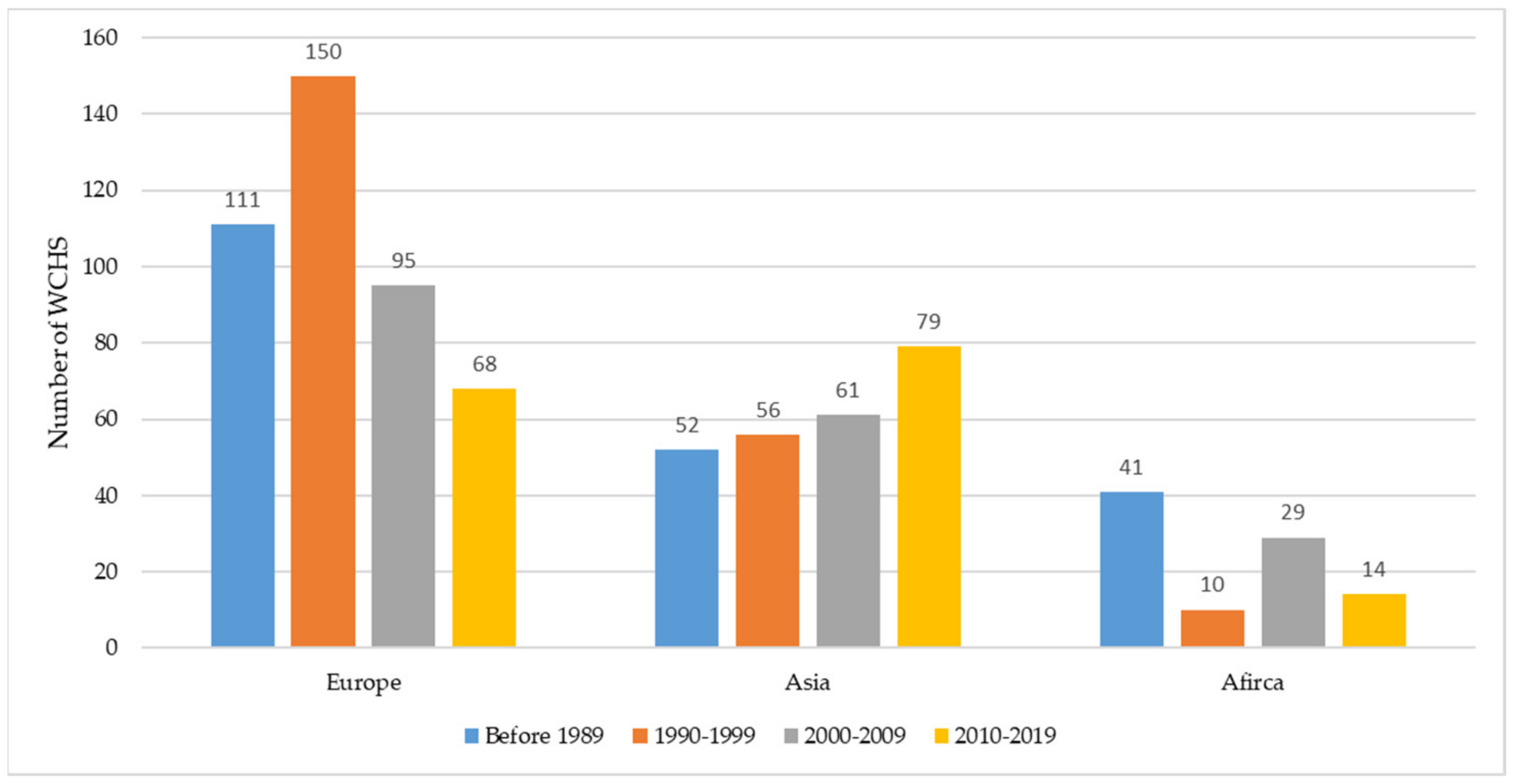
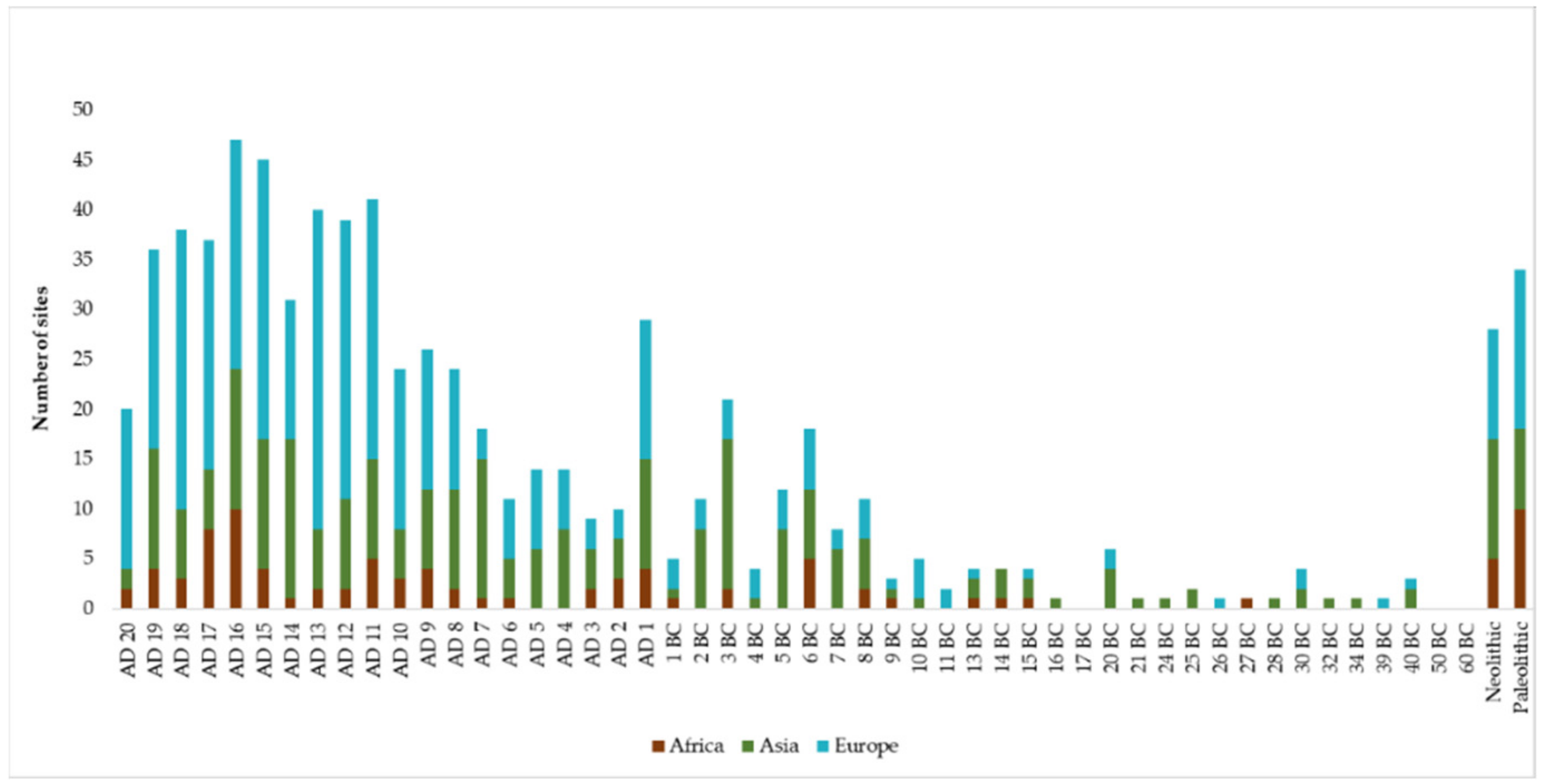
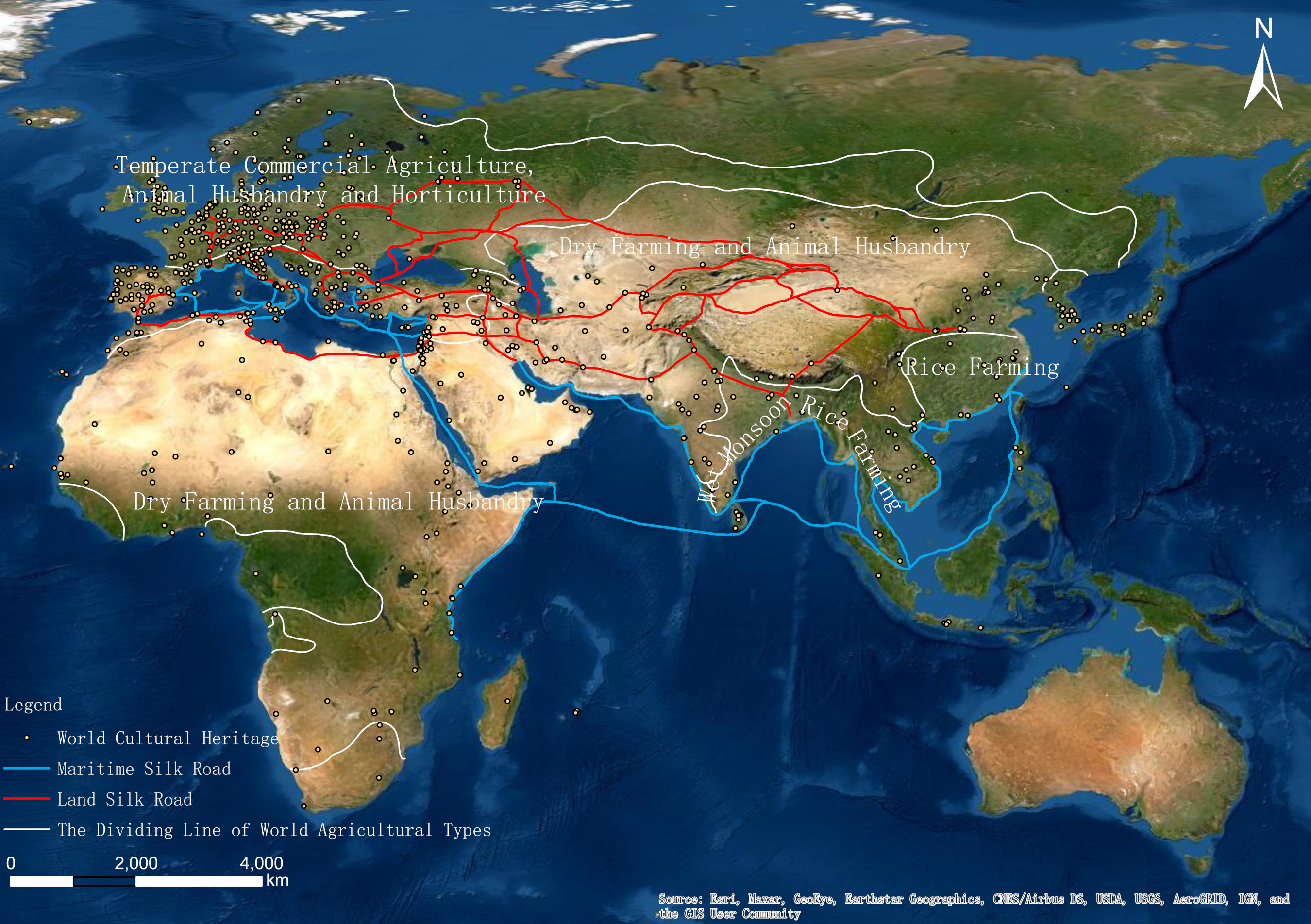


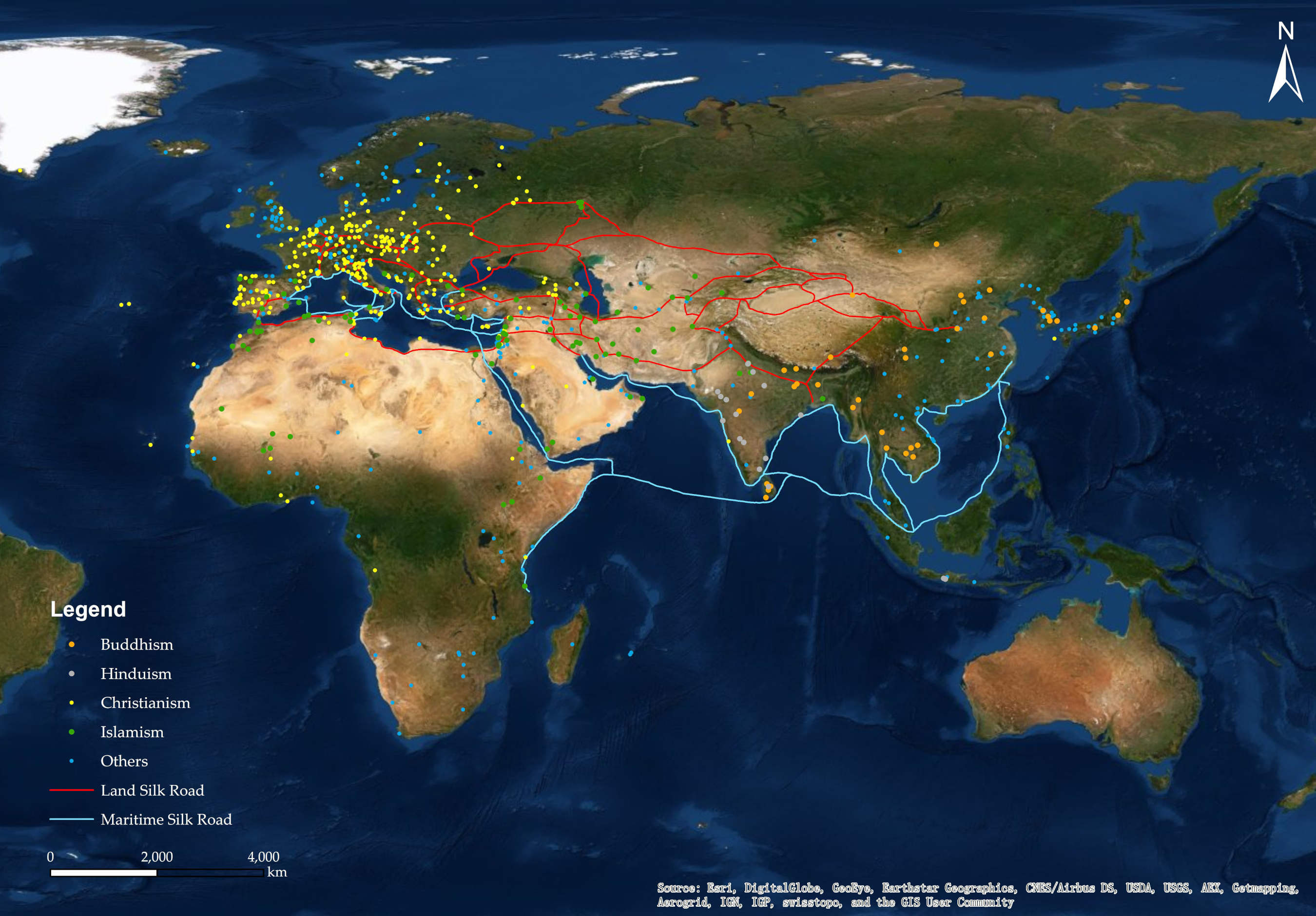
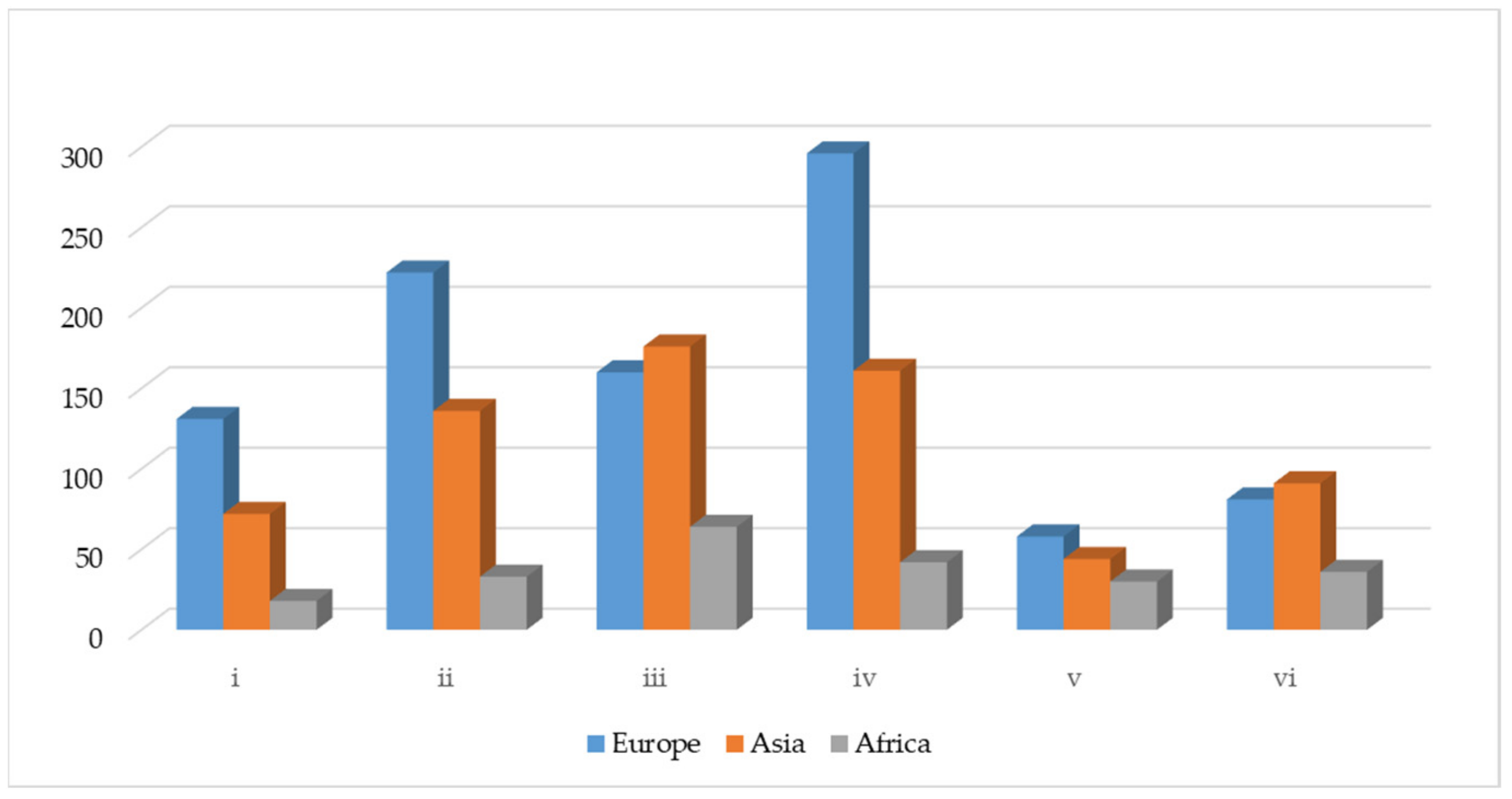
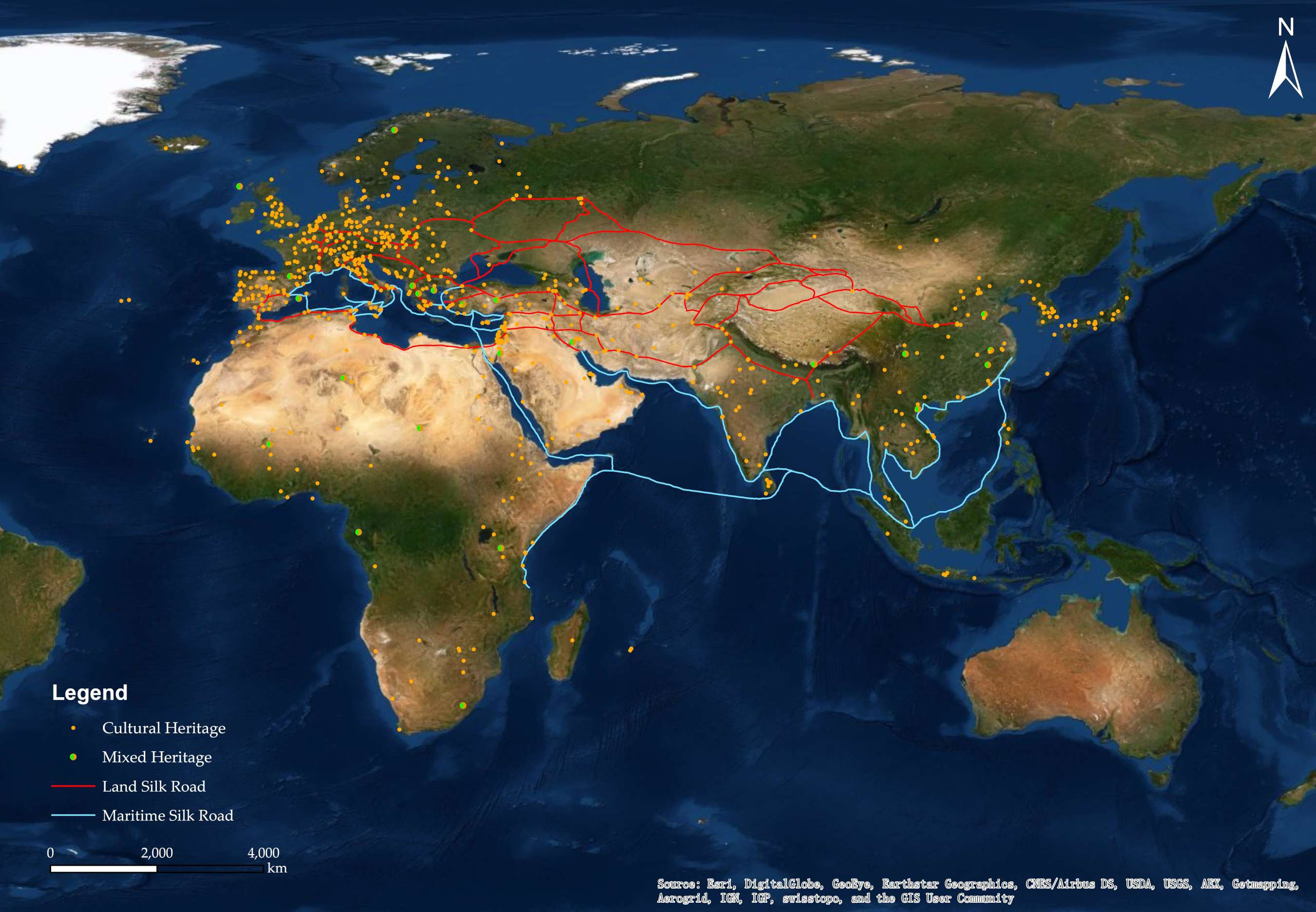


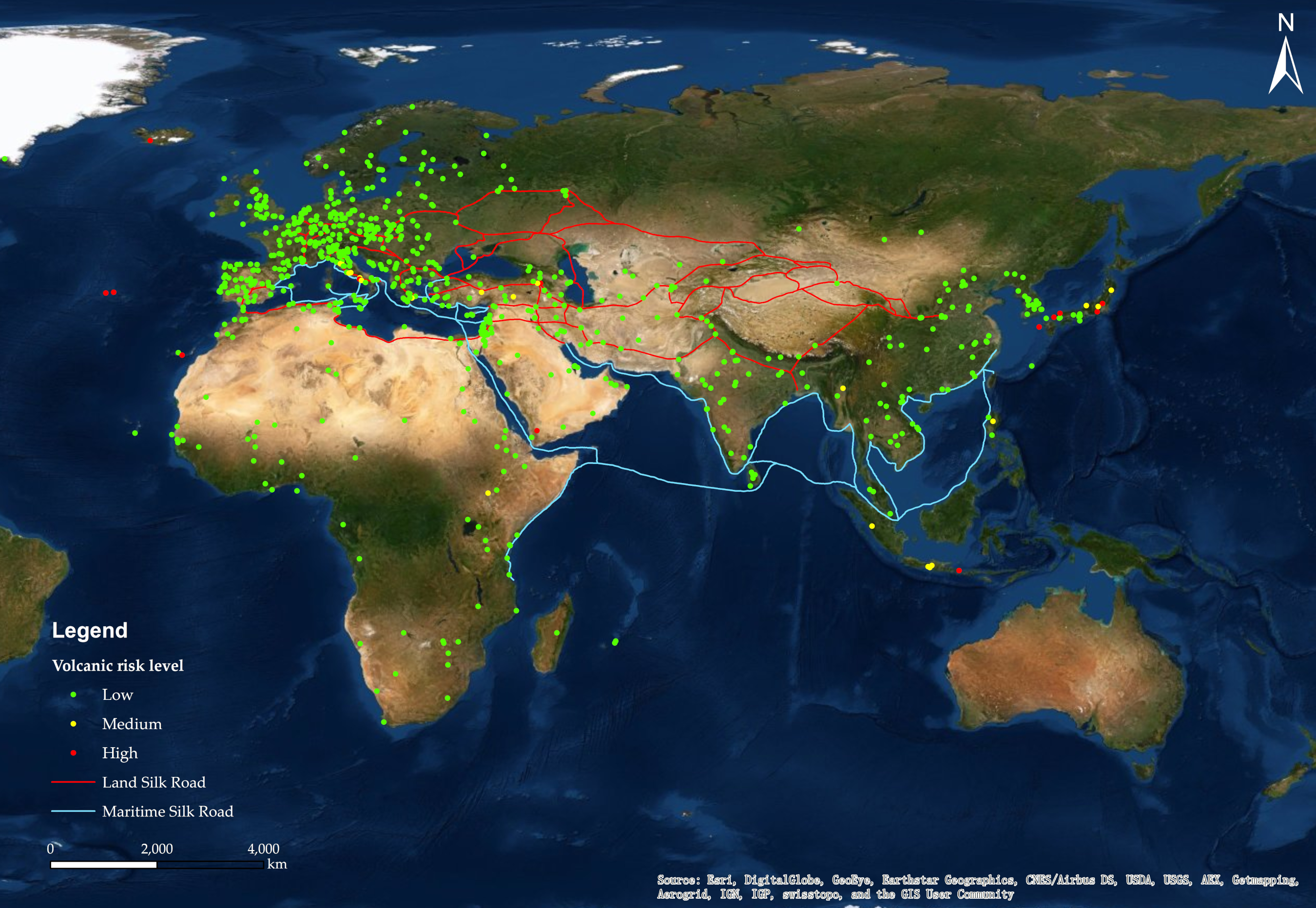
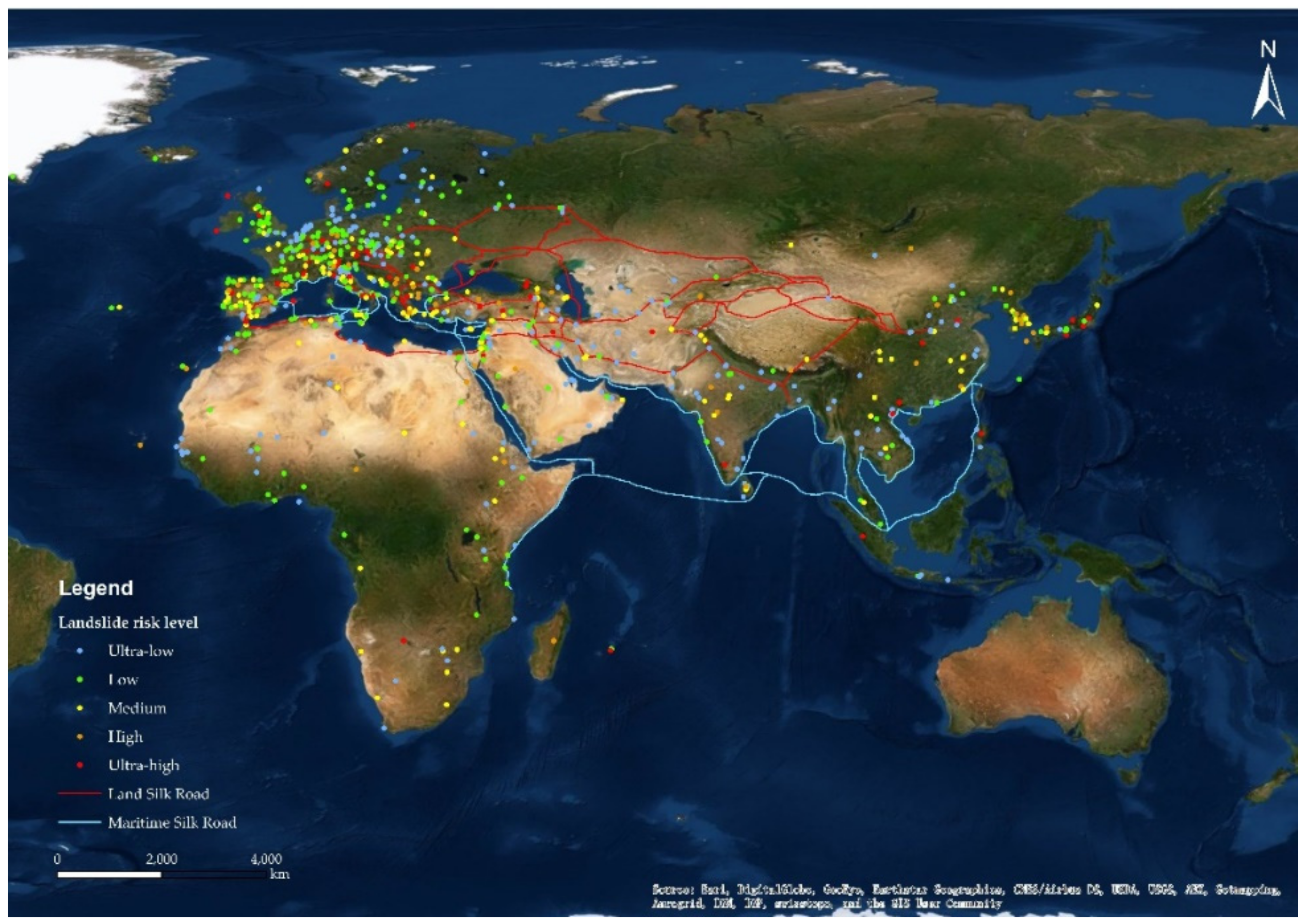
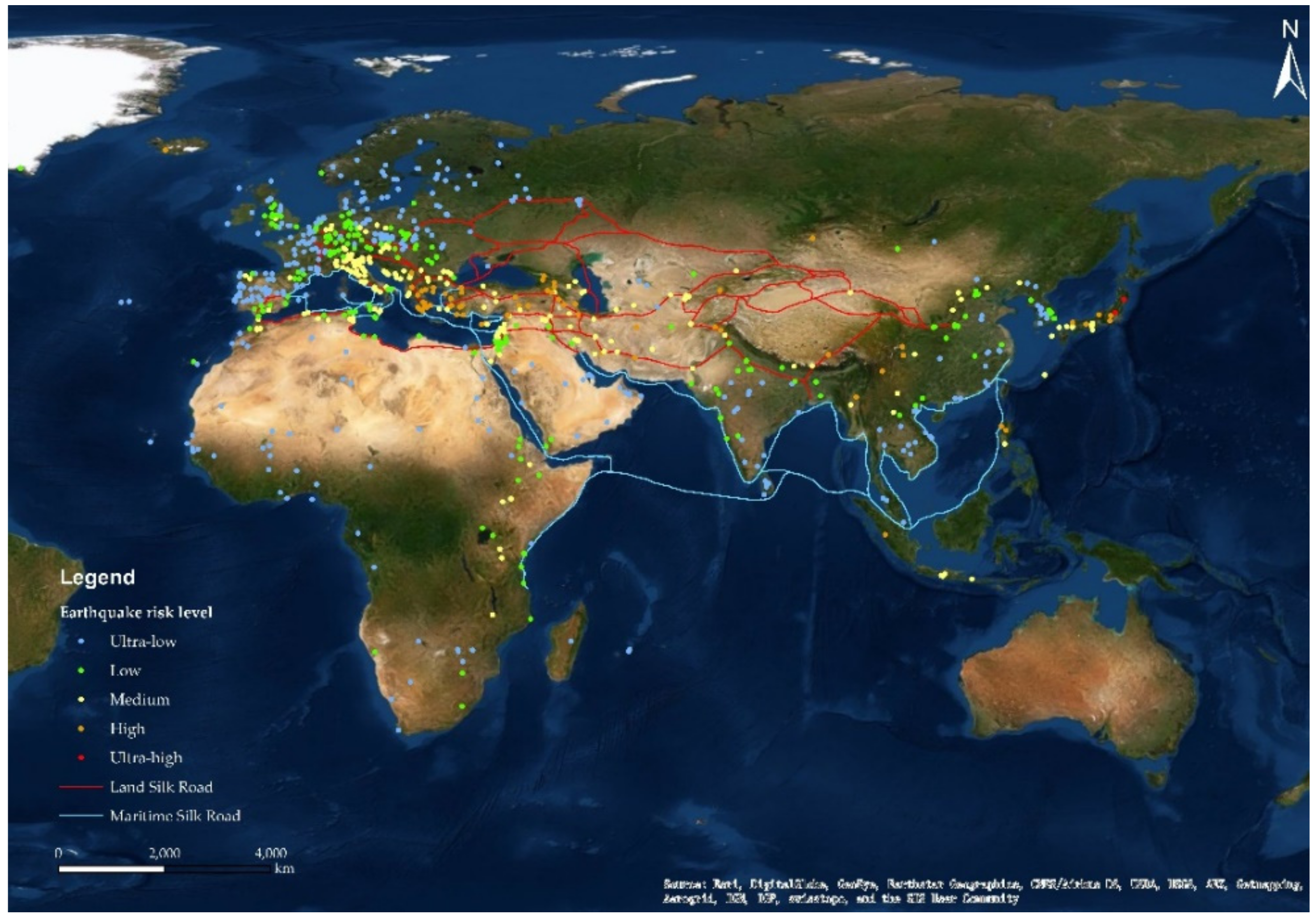
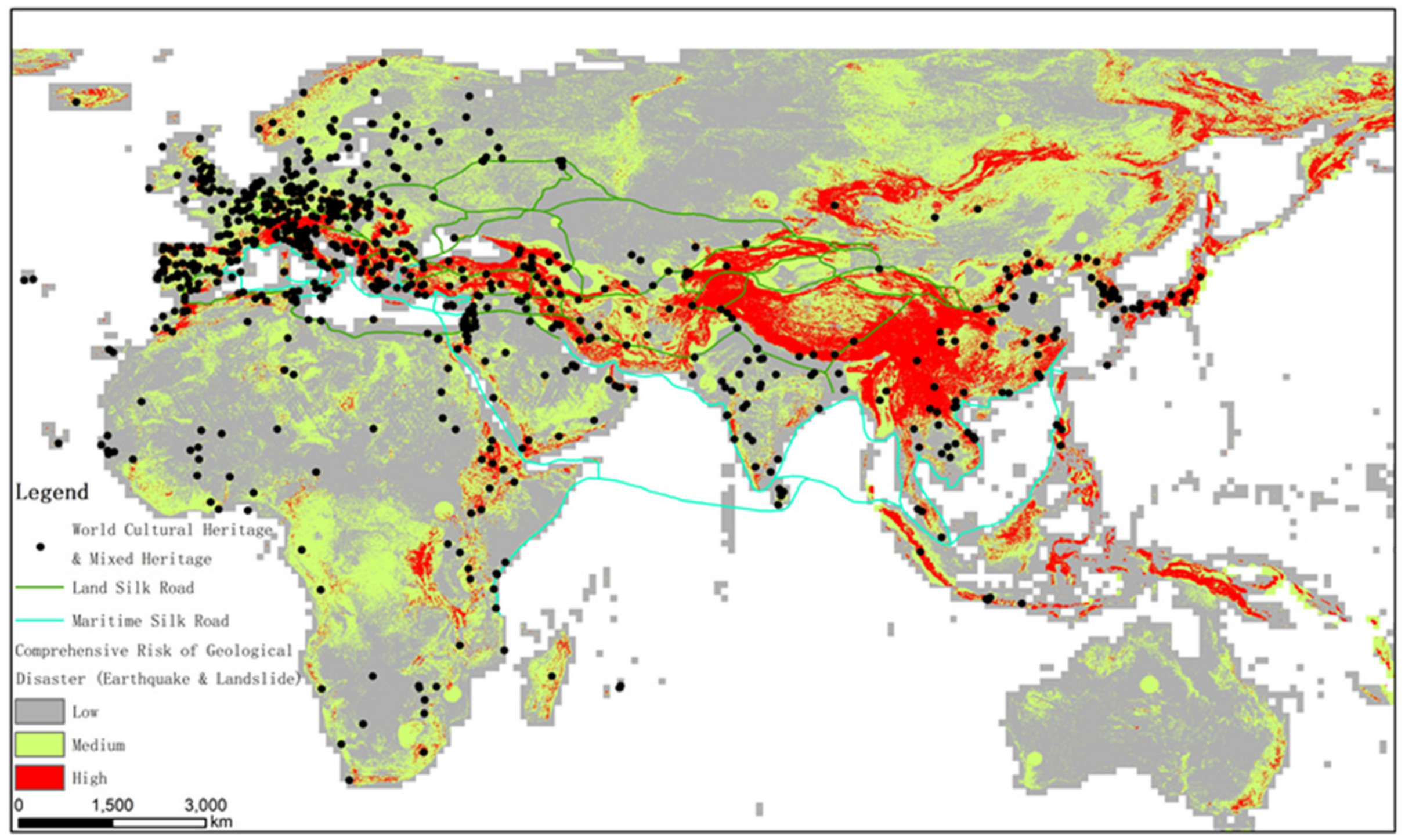

| Volcanic Risk Level | Low | Medium | High |
| Buffer Distance | >40 km | 20~40 km | ≤20 km |
| Landslide Risk Level | Ultra-Low | Low | Medium | High | Ultra-High |
|---|---|---|---|---|---|
| Susceptibility | 1 | 2 | 3 | 4 | 5 |
| Earthquake Risk Level | Ultra-Low | Low | Medium | High | Ultra-High |
|---|---|---|---|---|---|
| Seismic intensity | <6 | 6 | 7 | 8 | ≥9 |
| PGA/(cm/s2) | <39.2 | 39.2–88.3 | 88.3–186.4 | 186.4~372.8 | ≥372.8 |
| Material Type | Wooden Heritage | Earthen Heritage | Stone and Brick Heritage | Stone-Earthen Heritage | Stone-Wooden Heritage | Wood-Earthen Heritage | Steel Heritage | MixedHeritage |
|---|---|---|---|---|---|---|---|---|
| Frequency | 21 | 51 | 441 | 185 | 31 | 8 | 9 | 20 |
| Ratio | 6.70% | 2.70% | 57.60% | 24.20% | 4.00% | 1.00% | 1.20% | 2.60% |
| Civilization Type | Prehistory Civilization | Chinese Civilization | Indus Valley Civilization | Mesopotamian Civilization | Ancient Egyptian Civilization |
|---|---|---|---|---|---|
| Frequency | 72 | 41 | 6 | 6 | 6 |
| Ratio | 9.4% | 5.35% | 0.78% | 0.78% | 0.78% |
| Criteria | Number of Sites (Ratio in All Sites) | The Proportion of the Criteria in This Standard Selection, Listed Criteria in WCHS |
|---|---|---|
| I | 223 (11.88%) | 29.11% |
| II | 396 (21.10%) | 51.70% |
| III | 405 (21.58%) | 52.87% |
| IV | 506 (26.96%) | 66.06% |
| V | 135 (7.19%) | 17.62% |
| VI | 212 (11.29%) | 27.68% |
Publisher’s Note: MDPI stays neutral with regard to jurisdictional claims in published maps and institutional affiliations. |
© 2021 by the authors. Licensee MDPI, Basel, Switzerland. This article is an open access article distributed under the terms and conditions of the Creative Commons Attribution (CC BY) license (http://creativecommons.org/licenses/by/4.0/).
Share and Cite
Yao, Y.; Wang, X.; Lu, L.; Liu, C.; Wu, Q.; Ren, H.; Yang, S.; Sun, R.; Luo, L.; Wu, K. Proportionated Distributions in Spatiotemporal Structure of the World Cultural Heritage Sites: Analysis and Countermeasures. Sustainability 2021, 13, 2148. https://doi.org/10.3390/su13042148
Yao Y, Wang X, Lu L, Liu C, Wu Q, Ren H, Yang S, Sun R, Luo L, Wu K. Proportionated Distributions in Spatiotemporal Structure of the World Cultural Heritage Sites: Analysis and Countermeasures. Sustainability. 2021; 13(4):2148. https://doi.org/10.3390/su13042148
Chicago/Turabian StyleYao, Ya, Xinyuan Wang, Linlin Lu, Chuansheng Liu, Qiang Wu, Hongge Ren, Shu Yang, Ruiqi Sun, Lei Luo, and Kai Wu. 2021. "Proportionated Distributions in Spatiotemporal Structure of the World Cultural Heritage Sites: Analysis and Countermeasures" Sustainability 13, no. 4: 2148. https://doi.org/10.3390/su13042148
APA StyleYao, Y., Wang, X., Lu, L., Liu, C., Wu, Q., Ren, H., Yang, S., Sun, R., Luo, L., & Wu, K. (2021). Proportionated Distributions in Spatiotemporal Structure of the World Cultural Heritage Sites: Analysis and Countermeasures. Sustainability, 13(4), 2148. https://doi.org/10.3390/su13042148







